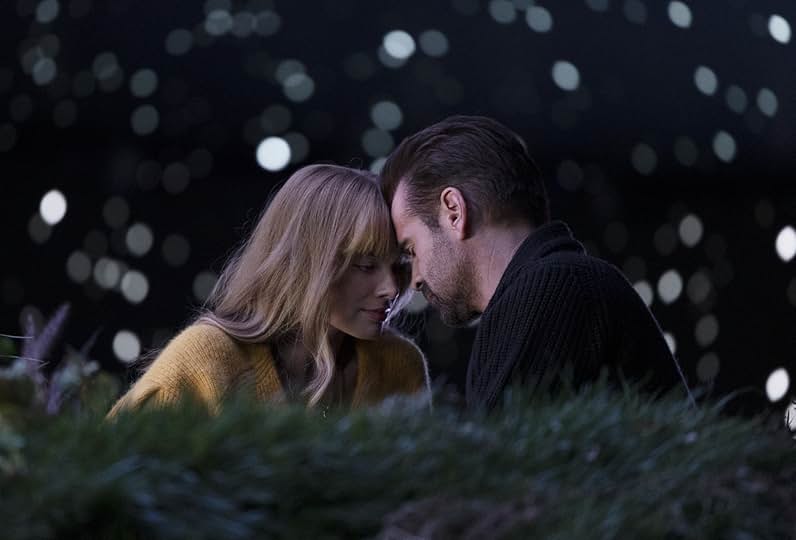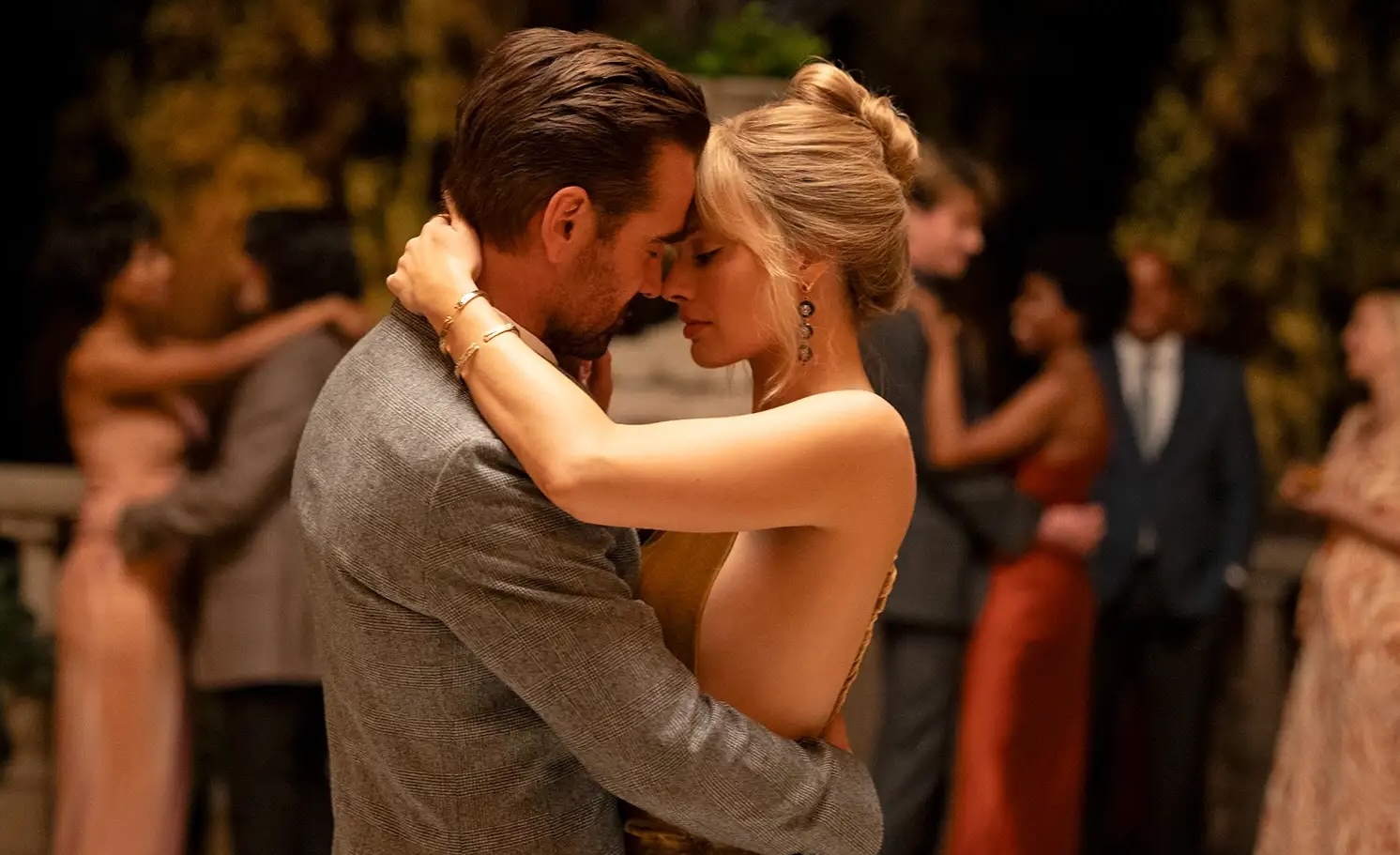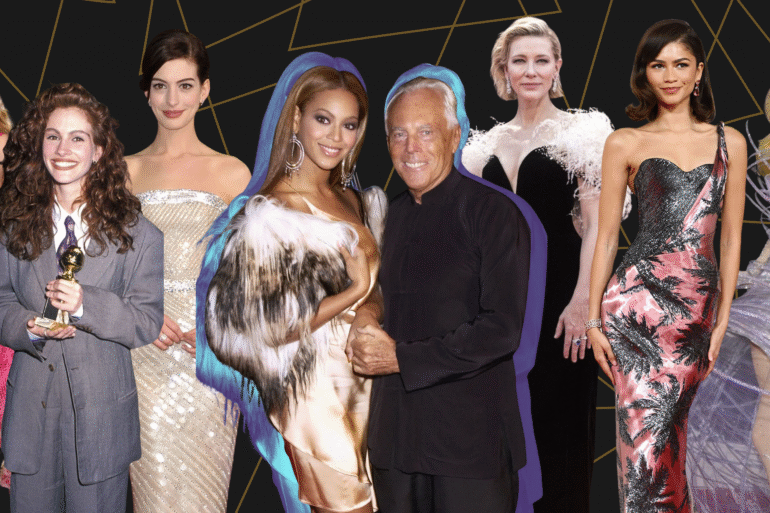Kogonada’s film is big, bold, and occasionally beautiful—but also twee, self-conscious, and oddly hollow.
Director Kogonada’s A Big Bold Beautiful Journey wants to be a soulful odyssey about healing childhood scars and learning how to love like adults. What it mostly delivers is a color-saturated road trip movie where the car has more personality than the leads.
Sarah (Margot Robbie) and David (Colin Farrell), meet at a wedding and decide to share a 1994 Saturn rental car home. So far, so rom-com. But instead of small talk and awkward flirtation, the car’s GPS (voiced with relish by Jodie Turner-Smith) hijacks the trip and directs them into a series of magical detours. These aren’t just pit stops at gas stations. They’re freestanding portals that lead straight into their formative traumas: the hospital where Sarah lost her mother, the auditorium where David’s teenage heart got crushed, and various other greatest hits from the Hall of Emotional Wounds.
It’s not exactly time travel—they can’t change the past—but more like cinematic regression therapy. Imagine Waze designed by a therapist who thinks healing means reliving your worst day over and over until you’re ready to kiss someone new.
A gimmick with some charm

To be fair, some of the conceits are amusing. Watching Farrell gleefully throw himself into the choreography of a high school musical is pure delight. Kevin Kline and Phoebe Waller-Bridge pop up as rental car clerks, chewing scenery with winks so broad you half expect them to mug at the camera. Waller-Bridge, doing a stern German accent, even spells out the film’s thesis: “Sometimes we have to perform to uncover the truth.”
It’s a clever line, though it sounds like it belongs on a tote bag in an overpriced bookstore.
The problem is that the film confuses contrivance with profundity. Kogonada’s trademark visual polish—dreamlike shots, saturated colors, indie playlist montages—looks great on a mood board, but onscreen it veers toward Pinterest-core. By the time Bright Eyes’ First Day of My Life kicks in, you half-expect a mason jar candle to appear in the frame.
Performances: One engages, one on autopilot

Robbie, usually electric with a wide-eyed ingenue-esque feel about her performances is dead behind the eyes here. Her Sarah comes across as stiff, encased in heavy makeup and wig-like hair, delivering lines like she’s in a high school play about divorce. Maybe that’s intentional—Sarah is supposed to be a predator hiding behind beauty—but the effect is more wooden than layered. In fact, her performance has the unyielding stiffness of an industrial lamppost.
Farrell, at 49, proves he’s still got it as a leading man and fares better; perhaps because he knows how to undercut whimsy with quiet, raw emotion. A scene at the wedding where he watches Sarah dance with another man contains more truth in one glance than half the dialogue. His eyes radiate longing and helplessness—a hungry stray staring into a butcher shop window. It’s funny, sad, and human, all without a single word.
Together, though? Sparks fail to fly. When Sarah and David finally kiss, it’s less fireworks and more flickering fluorescent light in a sad waiting room.
Related story: REVIEW: ‘KPop Demon Hunters’ is fast, fun, and has more heart than you’d expect
Related story: REVIEW: ‘Colin from Accounts’ is not your usual boy-meet-girl rom-com, that’s why you should watch it
Therapy as flirtation

One of the film’s biggest missteps is its insistence that trauma-dumping is romantic foreplay. Instead of letting chemistry develop naturally, Sarah and David constantly unload their parental baggage like emotional suitcases. At one point, Farrell even has to deliver the line, “I see you,” with all the sincerity of a corporate mindfulness seminar.
The script occasionally pokes fun at its own clunky dialogue — the characters tease each other about sounding rehearsed — but self-awareness doesn’t erase the fact that much of the writing is, indeed, stilted.
For a film about mystery doors, GPS therapy, and magical realism, A Big Bold Beautiful Journey is surprisingly predictable. If the car’s navigation system already knows where the couple should go, then where’s the suspense? And if revisiting trauma is the fast track to intimacy, then the film mistakes catharsis for connection.
By the final act, what should feel like a revelation lands more like a road sign flashing: “Stop. Do Not Enter.”
Kogonada’s film is big, bold, and occasionally beautiful—but also twee, self-conscious, and oddly hollow. It wants to convince us that love is forged through vulnerability and performance, but often feels like an exercise in aesthetic posturing.
There are moments of charm, yes. Farrell’s sincerity, the eccentric cameos, the odd spark of magic. But as a whole, A Big Bold Beautiful Journey proves that you can dress up therapy in neon lights and magical doors—but it’s still trauma-dumping on a first date.
It’s the cinematic equivalent of a hipster carrying around an old iPod in a hand-carved wooden case—stylish, bespoke, and slightly ridiculous.
Rating: 2.5/5
Related story: ‘Materialists’: Love, money, and the messy choices in between
Related story: REVIEW: ‘The Life of Chuck’ and dancing at the end of the world






